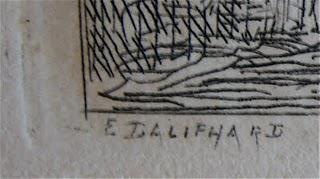 Édouard Daliphard, Etched signature
Édouard Daliphard, Etched signatureMy etching by Daliphard is a street scene executed with an Impressionist spareness. It is the only etching by Édouard Daliphard that I have come across, and dates from the very end of his short life. It may be the only etching he ever made. It was commissioned from Daliphard by the Impressionist printmaker Henri Guérard for the short-lived journal Paris à l'Eau-Forte, which was published from 1873-1876. I have not yet been able to see a complete run of this journal, so I do not know if Daliphard's etching was published in the original run. Quite probably it did not appear until after Daliphard's death when - in 1879 or 1880 - the editor Richard Lesclide tried to revive the publication. My sense is that Lesclide was left with a lot of debts after the failure of Paris à l'Eau-Forte, When his own fortunes had revived, largely due to his employment as secretary to Victor Hugo, he had a go at reviving the journal. It seems he had a supply of etchings already printed by Delâtre for the original journal, and also a supply of copper plates, either previously published or commissioned but never published. Freshly-printed etchings were printed by Quantin, not Delâtre. The new version of Paris à l'Eau-Forte survived for two volumes, the second of which was renamed Eaux-fortes Parisiennes (though the dustwrapper still retained the old title). The economic desperation of this publication may be tested by comparison of two different copies. My first copy of Eaux-fortes Parisiennes has 26 etchings. My second copy, with exactly the same text, has only 17. Only 5 etchings are repeated, and not in any sort of rational order - for instance the frontispiece in the first copy, by Marc Antoine Claude Monnin, is repeated in the second, but opposite page 168. There are also several repeat etchings from my copy of the first volume of this ill-fated relaunch. There are no lists of the etchings, and in all 3 volumes there are some I cannot confidently attribute to a particular artist.
 Édouard Daliphard, Street sceneEtching c.1876
Édouard Daliphard, Street sceneEtching c.1876Luckily, one of the etchings present in both my copies of Eaux-fortes Parisiennes is this deft work by Édouard Daliphard. The economy of line in this etching just takes my breath away. At a time when etching was all about filling the page with black, Daliphard holds back. His philosophy here is less-is-more - and he is right. It's perhaps hard now to realise how daring it was to leave so much detail out, and to simply suggest the subject rather than delineate it. Daliphard was influenced by Corot and the Barbizon School, and it seems likely that if he had lived he would have allied himself with the Impressionists. In 1875 Daliphard became a very early patron of Impressionism when he bought Berthe Morisot's La Lecture for 210 francs; the painting is now in the Cleveland Museum of Art.

